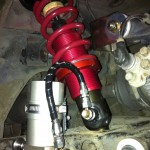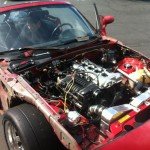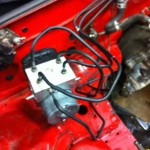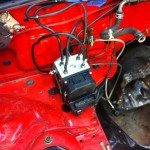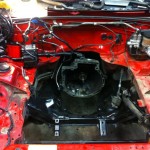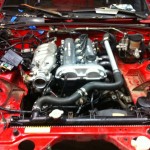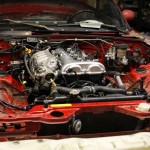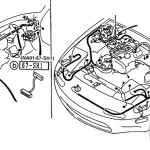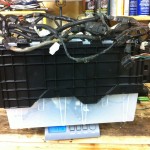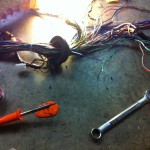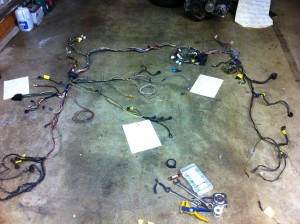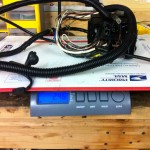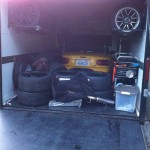 Because of the alignment and truck issues, we, of course, had another frantic last minute prep session. We spent Monday afternoon pulling the front UCAs off to bend them more, reinstalling them, and getting the car to an alignment shop with zero notice in time for them to work on it. While some of that was in process, we had to pull the alternator off the truck and get a rebuilt alternator and install it. That evening we finally got to clean up some last minute stuff on the car and packed up the rig to head to Lincoln.
Because of the alignment and truck issues, we, of course, had another frantic last minute prep session. We spent Monday afternoon pulling the front UCAs off to bend them more, reinstalling them, and getting the car to an alignment shop with zero notice in time for them to work on it. While some of that was in process, we had to pull the alternator off the truck and get a rebuilt alternator and install it. That evening we finally got to clean up some last minute stuff on the car and packed up the rig to head to Lincoln.
2 days of towing later, we arrived to glorious 90 degrees and humid Lincoln, NE. We spent Thursday doing practice starts to figure out how to launch the thing (which neither of us ever got any good at – my best 60ft was 2.01s.) Everything was going well, so we retired to beer.
Friday (ProSolo day 1) morning, I got 3 runs then the car sputtered and died sitting in line to take my 4th run and wouldn’t restart. We pushed it off to the 2nd driver line and let it sit for a minute. We checked everything – nothing obvious was wrong, but a minute later we tried firing the car back up, and it happily did. My dad then got 2 runs in before it died in the same way for him and we retired to impound.
Very perplexed, we guessed it was a fueling issue, and I’d been worried about my fuel pump since the Packwood weekend of harness melting/shorting. So, at lunch we changed the fuel pump to the new Deutchwerks pump. I didn’t get a right side run (apparently I rolled out of my one right side run, grr), so my dad got to go first. We sent him out without a hood for afternoon runs, on the off chance something was overheating, to get some more ventilation into the engine bay. He got his 4 runs in, so we hoped it was fixed and put the hood on for my runs. I got one run before it died again briefly after I departed for my second run. We again retired to impound and had an evening to consider.
Fortunately, I had noticed, when it wigged out on me, that the tach was going nuts, implying that the ECU had lost cam/crank sync (or something far more heinous, possibly.) I asked around the paddock and found two very nice competitors (Bill Schenker and Mike Heinitz) that had spare crank and cam angle sensors to loan me, and swapped them onto the car.
The next day, we decided the better part of valor was to run without the hood again (but we “replaced” the hood with a strip of tape, which is technically legal under SSM rules, stupid as that may be) and I went out for my runs. The car had no issues, and I managed to save for 3rd place, and my dad also got his 4 runs in without issue. When we tried to start the car up again after weighing it, it wouldn’t start, or even show any signs of ignition signal. We towed it back to the paddock and poked around at it for a bit.
I found nothing wrong, but finally decided to try swapping the main relay out for a spare I had lying around, and the car sprung to life. That relay had likely been damaged in the wiring debacle of the Packwood weekend, but it’s still a little distressing. The car seemed fine after that, so we declared victory and went for celebratory BBQ and beer.
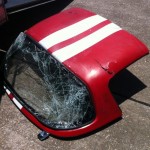
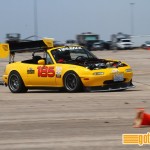 The NT went mostly without issue. They yelled at us after the ProSolo, because apparently our exhaust was blowing 103dB consistently (limit of 100dB), so we had to attach a clamp on muffler for the tour. I had a small power burble on day 1 in the middle of my third run, but it’s vaguely possible it was just fuel starvation. We made it through — I got 3rd again, 1.4 off the win. The only day two issue was when, on the way out to grid for our day 2 heat, my dad drove the truck over the hardtop I’ve been using to keep the car dry/sealed overnight, which is now forcing me to come up with some new solution…
The NT went mostly without issue. They yelled at us after the ProSolo, because apparently our exhaust was blowing 103dB consistently (limit of 100dB), so we had to attach a clamp on muffler for the tour. I had a small power burble on day 1 in the middle of my third run, but it’s vaguely possible it was just fuel starvation. We made it through — I got 3rd again, 1.4 off the win. The only day two issue was when, on the way out to grid for our day 2 heat, my dad drove the truck over the hardtop I’ve been using to keep the car dry/sealed overnight, which is now forcing me to come up with some new solution…
On the drive home, so far, I’ve ordered brand new replacement relays from Mazda and also new crank and cam angle sensors. I noticed the cam sensor and the main relay had both been superceded, and reading up on miata.net, it looks like my issues are pretty known issues, so I’m vaguely hopeful that I’ve discovered the cause(s) of my more major problems.
We also had a chance to play with the Hoosiers vs. Goodyears at the Prosolo, and we both agreed that the Goodyears make the car much more drivable, so for the forseable future, it looks like it’s going to be a Goodyear car. They seem to be able to put down power much better, and also they don’t overheat nearly as badly as the Hoosiers do, both of which are good things for an SSM car, especially at a hot site like Lincoln.
I hopefully will have time coming up to work on some of the other projects for the car: a front brakes solution, possibly moving to a permanent carbon hard top, venting the hood for real, tuning the rear wing, canards, etc. The really short summary, though, is that the car, for its first showing, when it was working, proved that a Miata can get it done in SSM (if I stopped driving like such an idiot.) So, despite all the other stresses of the weekend, it was a resounding success. I also had some more time to mess with the data system that I’m developing, and worked some of the usability kinks out, which was helpful at the events and should be even more useful as the year goes on…
